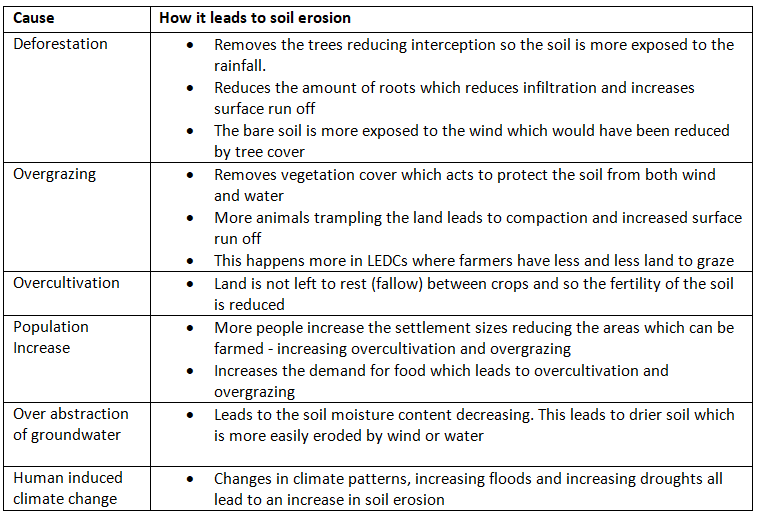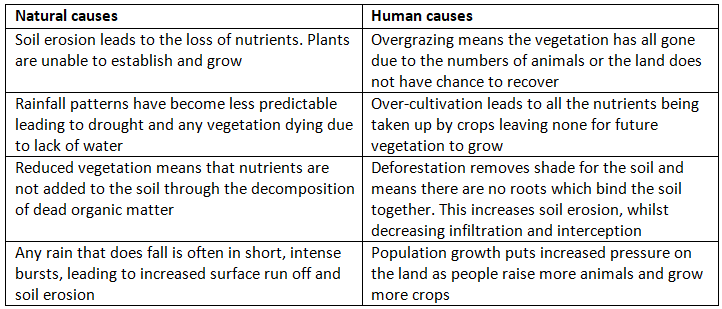Class 10 Exam > Class 10 Notes > Geography for GCSE/IGCSE > Soil Erosion & Desertification
Soil Erosion & Desertification | Geography for GCSE/IGCSE - Class 10 PDF Download
Soil Erosion
- Soil erosion occurs when the topsoil is gradually worn away by the forces of wind or water.
- This natural process is exacerbated by human activities that leave the soil vulnerable to the erosive effects of wind and water.

- Salinisation poses a growing concern in many semi-arid regions. It occurs due to intense evaporation rates, causing groundwater to rise to the surface.
- As the groundwater evaporates, it leaves behind salts on or within the topsoil, rendering the land unsuitable for many crops.
- The accumulation of salts makes the soil toxic to crops, leading to the land becoming unusable for agricultural purposes.
- Prolonged soil erosion can eventually contribute to the process of desertification in affected areas.
Desertification
- Desertification is caused by both natural factors and human activities
- Many of the natural causes may be made worse by climate change


Sustainable Management of Soil Erosion and Desertification
- Sustainable management of soil erosion and desertification involves addressing underlying causes.
- Various political and social measures are necessary.
Education
Education plays a crucial role, encompassing:
- Teaching sustainable farming techniques like agroforestry and crop rotation to maintain soil health.
- Promoting family planning to curb population growth.
Agroforestry
Agroforestry integrates agriculture with forestry, preserving trees, which:
- Mitigates deforestation.
- Offers shade, enhancing infiltration and interception, thus reducing soil erosion.
- Provides organic matter and nutrients to enrich the soil.
Question for Soil Erosion & DesertificationTry yourself: What is one of the causes of desertification?View Solution
Afforestation
Afforestation, like the Great Green Wall initiative in the Sahel, aids in reversing desertification by:
- Root systems binding soil, thereby reducing erosion.
- Canopy providing shade, preventing soil dehydration and erosion from direct rainfall impact.
- Nutrient replenishment through fallen leaves and branches.
- Increasing animal and insect activity, improving soil health.
Contour Stones and Terraces
Contour stones and terraces are effective in minimizing soil erosion through:
- Preventing soil erosion caused by wind or water runoff.
- Enhancing water infiltration and minimizing surface runoff.
- Retaining dead organic matter in situ, facilitating decomposition and nutrient enrichment of the soil.
The document Soil Erosion & Desertification | Geography for GCSE/IGCSE - Class 10 is a part of the Class 10 Course Geography for GCSE/IGCSE.
All you need of Class 10 at this link: Class 10
|
55 videos|68 docs|78 tests
|
FAQs on Soil Erosion & Desertification - Geography for GCSE/IGCSE - Class 10
| 1. What are the main causes of soil erosion? |  |
Ans. Soil erosion can be caused by factors such as deforestation, overgrazing, improper agricultural practices, and construction activities that remove vegetation cover and expose the soil to erosion.
| 2. How does desertification contribute to soil erosion? |  |
Ans. Desertification leads to the degradation of land in arid and semi-arid regions, making the soil more vulnerable to erosion due to the lack of vegetation cover and the increased likelihood of wind and water erosion.
| 3. What are the potential consequences of soil erosion on the environment? |  |
Ans. Soil erosion can lead to reduced soil fertility, sedimentation of water bodies, increased flooding, loss of biodiversity, and degradation of ecosystems, impacting both the environment and human livelihoods.
| 4. How can soil erosion and desertification be prevented or mitigated? |  |
Ans. Strategies to prevent soil erosion and desertification include planting trees and grass to stabilize soil, implementing conservation tillage practices, constructing terraces and contour bunds, and implementing sustainable land management practices.
| 5. How does climate change exacerbate soil erosion and desertification? |  |
Ans. Climate change can increase the frequency and intensity of extreme weather events such as droughts and heavy rainfall, which can accelerate soil erosion and desertification processes, making it more challenging to manage these environmental issues.
Related Searches















